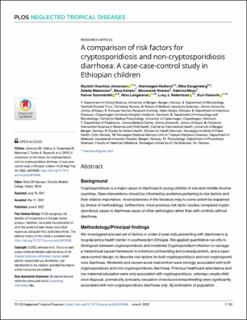| dc.contributor.author | Johansen, Øystein Haarklau | |
| dc.contributor.author | Abdissa, Alemseged | |
| dc.contributor.author | Zangenberg, Mike | |
| dc.contributor.author | Mekonnen, Zeleke | |
| dc.contributor.author | Eshetu, Beza | |
| dc.contributor.author | Sharew, Bizuwarek | |
| dc.contributor.author | Moyo, Sabrina John | |
| dc.contributor.author | Sommerfelt, Halvor | |
| dc.contributor.author | Langeland, Nina | |
| dc.contributor.author | Robertson, Lucy | |
| dc.contributor.author | Hanevik, Kurt | |
| dc.date.accessioned | 2022-11-09T13:51:09Z | |
| dc.date.available | 2022-11-09T13:51:09Z | |
| dc.date.created | 2022-06-15T09:46:31Z | |
| dc.date.issued | 2022 | |
| dc.identifier.issn | 1935-2727 | |
| dc.identifier.uri | https://hdl.handle.net/11250/3030978 | |
| dc.description.abstract | Background: Cryptosporidiosis is a major cause of diarrhoea in young children in low-and-middle-income countries. New interventions should be informed by evidence pertaining to risk factors and their relative importance. Inconsistencies in the literature may to some extent be explained by choice of methodology, furthermore, most previous risk factor studies compared cryptosporidiosis cases to diarrhoea cases of other aetiologies rather than with controls without diarrhoea.
Methodology/Principal findings: We investigated a broad set of factors in under-2-year-olds presenting with diarrhoea to a hospital and a health center in southwestern Ethiopia. We applied quantitative cut-offs to distinguish between cryptosporidiosis and incidental Cryptosporidium infection or carriage, a hierarchical causal framework to minimize confounding and overadjustment, and a case-case-control design, to describe risk factors for both cryptosporidiosis and non-cryptosporidiosis diarrhoea. Moderate and severe acute malnutrition were strongly associated with both cryptosporidiosis and non-cryptosporidiosis diarrhoea. Previous healthcare attendance and low maternal education were only associated with cryptosporidiosis, whereas unsafe child stool disposal, prematurity and early cessation of exclusive breastfeeding were significantly associated with non-cryptosporidiosis diarrhoea only. By estimation of population attributable fractions, socioeconomic factors—specifically low maternal education—and public tap water use, were apparently more important risk factors for cryptosporidiosis than for non-cryptosporidiosis diarrhoea.
Conclusions/Significance: Nutritional management of moderate acute malnutrition may be an effective intervention against cryptosporidiosis, particularly if combined with targeted therapy for cryptosporidiosis which, again, may mitigate nutritional insult. Focused caregiver education in healthcare settings and follow-up of children with acute malnutrition may prevent or improve outcomes of future episodes of cryptosporidiosis. | en_US |
| dc.language.iso | eng | en_US |
| dc.publisher | PLOS | en_US |
| dc.rights | Navngivelse 4.0 Internasjonal | * |
| dc.rights.uri | http://creativecommons.org/licenses/by/4.0/deed.no | * |
| dc.title | A comparison of risk factors for cryptosporidiosis and non-cryptosporidiosis diarrhoea: A case-case-control study in Ethiopian children | en_US |
| dc.type | Journal article | en_US |
| dc.type | Peer reviewed | en_US |
| dc.description.version | publishedVersion | en_US |
| dc.rights.holder | Copyright 2022 The Author(s) | en_US |
| dc.source.articlenumber | e0010508 | en_US |
| cristin.ispublished | true | |
| cristin.fulltext | original | |
| cristin.qualitycode | 1 | |
| dc.identifier.doi | 10.1371/journal.pntd.0010508 | |
| dc.identifier.cristin | 2031933 | |
| dc.source.journal | PLoS Neglected Tropical Diseases | en_US |
| dc.identifier.citation | PLoS Neglected Tropical Diseases. 2022, 16 (6), e0010508. | en_US |
| dc.source.volume | 16 | en_US |
| dc.source.issue | 6 | en_US |

